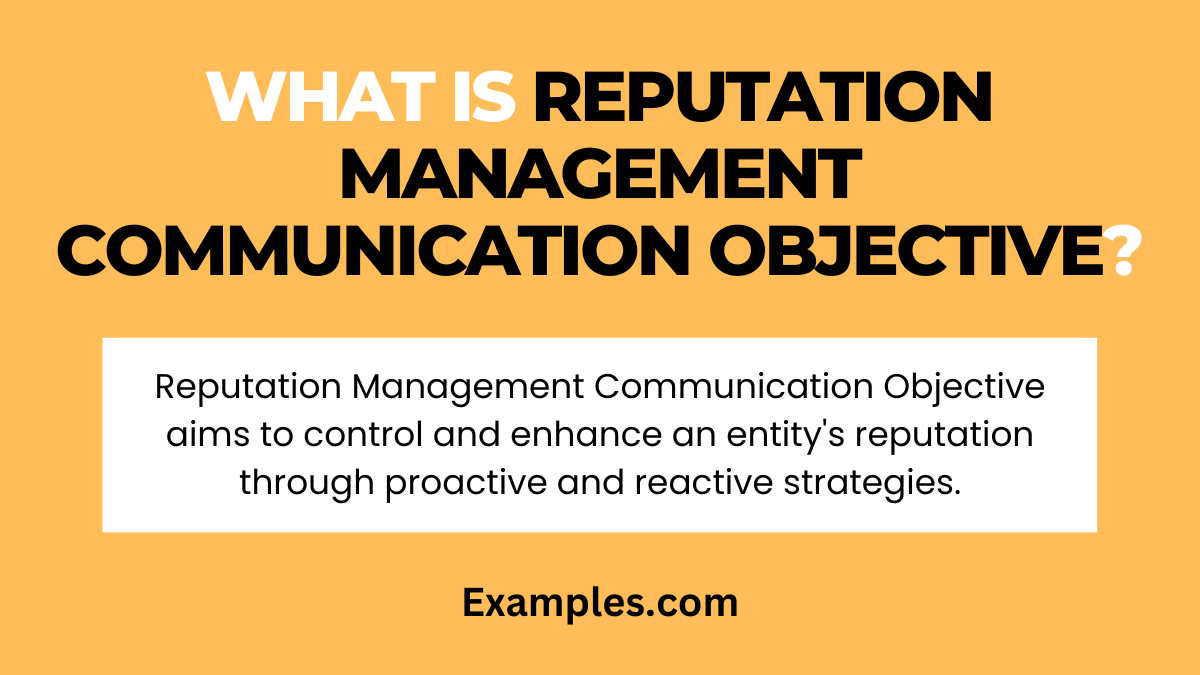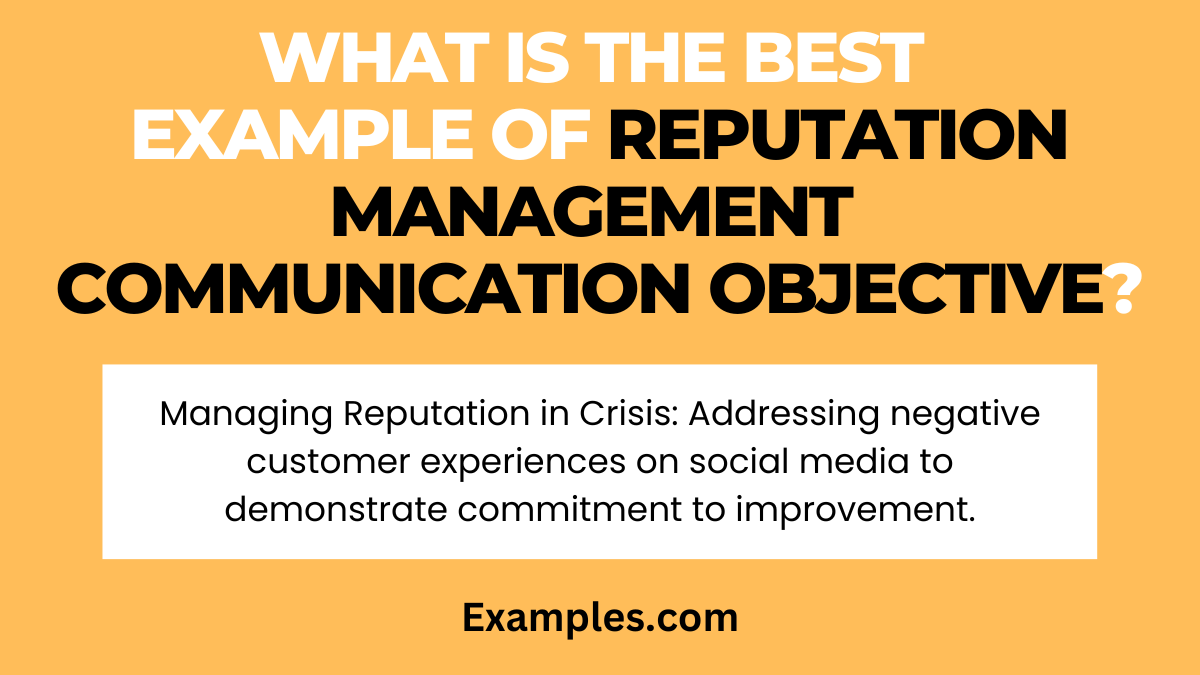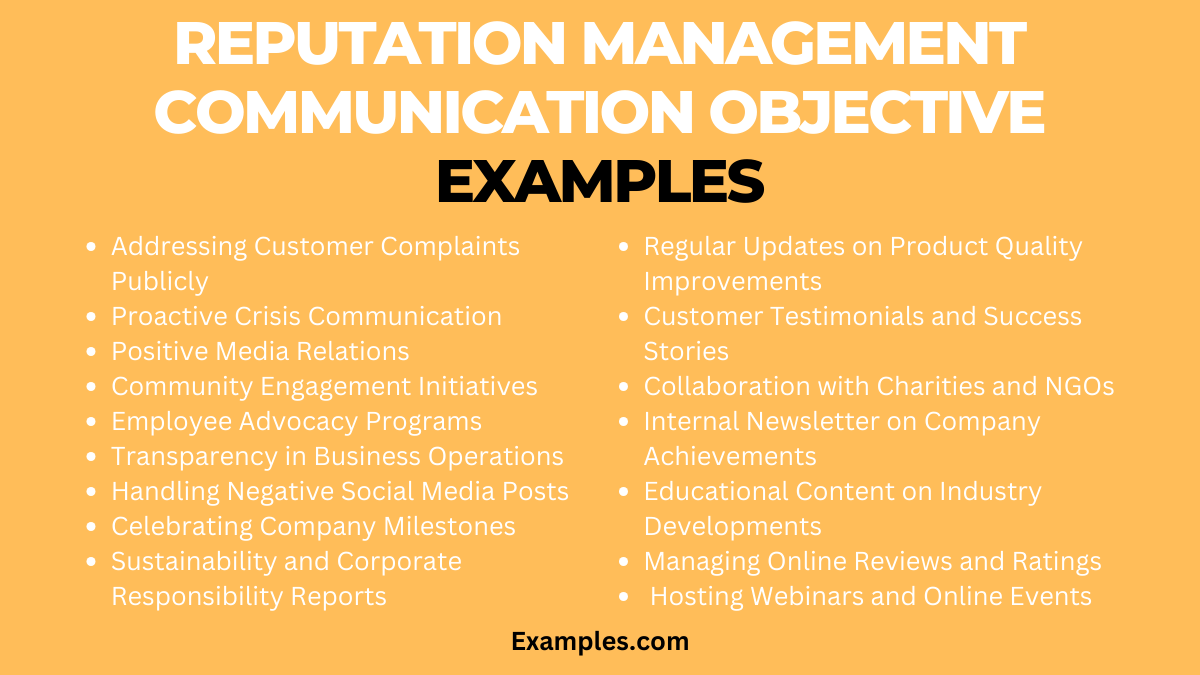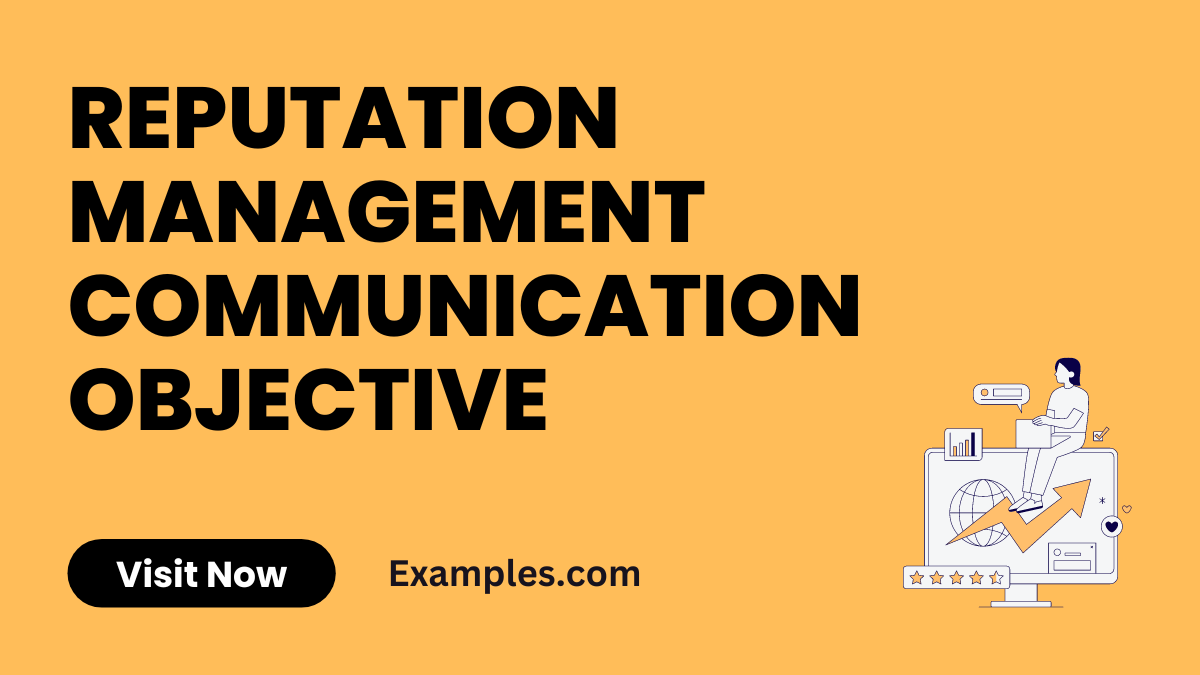Reputation Management Communication Objective
The Reputation Management Communication Objective is vital for maintaining and enhancing a brand’s or individual’s image in the public eye. It involves strategic communication tactics to influence how an organization is perceived by its stakeholders. This objective is especially crucial in times of crisis or negative publicity. Employing Communication Objectives that effectively manage reputation can help in restoring trust, maintaining customer loyalty, and preserving the integrity of the brand or individual.
What is Reputation Management Communication Objective?

Reputation Management Communication Objective refers to the strategies and actions taken to influence or control an entity’s reputation. This objective encompasses monitoring public perception, addressing negative sentiments, and promoting positive messages. The goal is to shape the narrative in a way that reflects positively on the brand or individual, especially in handling criticisms or crises. It’s a proactive and reactive approach to protect and enhance reputational value.
What is the Best Example of Reputation Management Communication Objective?

A classic example of a Reputation Management Communication Objective is a company’s response to a customer service crisis. Suppose a negative customer experience goes viral on social media. In that case, the company’s objective would be to address the issue publicly, offer a solution or compensation, and communicate the steps taken to prevent future occurrences. This approach aims to mitigate the negative impact and demonstrate the company’s commitment to customer satisfaction and continuous improvement.
20 Reputation Management Communication Objective Examples

- Addressing Customer Complaints Publicly: Responding promptly to negative reviews online.
Example: “We sincerely apologize and are addressing this issue immediately.” - Proactive Crisis Communication: Communicating effectively during a crisis situation.
Example: “We’re committed to resolving this situation and keeping you informed.” - Positive Media Relations: Building and maintaining good relationships with the media.
Example: “We value our relationship with the media and appreciate their fair coverage.” - Community Engagement Initiatives: Participating in community events to bolster brand image.
Example: “Join us at the community clean-up this weekend.” - Employee Advocacy Programs: Encouraging employees to positively represent the company.
Example: “Our employees are our best ambassadors, sharing our company’s values.” - Transparency in Business Operations: Communicating openly about business practices.
Example: “We pride ourselves on transparency in all our operations.” - Handling Negative Social Media Posts: Responding to negative posts constructively.
Example: “We understand your concerns and are here to help.” - Celebrating Company Milestones: Sharing positive news and achievements.
Example: “We’re thrilled to celebrate our 20th anniversary with you.” - Sustainability and Corporate Responsibility Reports: Publishing reports on CSR activities.
Example: “Our annual sustainability report is now available online.” - Regular Updates on Product Quality Improvements: Communicating about improvements and updates.
Example: “We’ve enhanced our product quality based on your feedback.” - Customer Testimonials and Success Stories: Sharing positive customer experiences.
Example: “Hear what our satisfied customers have to say about us.” - Collaboration with Charities and NGOs: Partnering with organizations for social good.
Example: “Our partnership with local NGOs underscores our commitment to the community.” - Internal Newsletter on Company Achievements: Keeping employees informed and engaged.
Example: “Our latest newsletter highlights our team’s achievements.” - Educational Content on Industry Developments: Positioning the brand as a thought leader.
Example: “Explore our insights on the latest industry trends.” - Managing Online Reviews and Ratings: Monitoring and responding to online feedback.
Example: “Thank you for your review; your feedback helps us improve.” - Hosting Webinars and Online Events: Engaging with the audience on relevant topics.
Example: “Join our webinar to learn more about industry best practices.” - Active Participation in Industry Forums: Contributing to industry discussions.
Example: “Our team regularly contributes to key industry forums.” - Influencer Partnerships for Positive Branding: Collaborating with influencers to enhance brand image.
Example: “Our collaboration with influencers aligns with our brand values.” - Social Responsibility Campaigns: Showcasing commitment to social causes.
Example: “Our latest campaign supports environmental sustainability.” - Publishing Whitepapers and Research: Sharing expertise and knowledge.
Example: “Our whitepaper discusses innovative solutions in our field.”
Each of these examples demonstrates how strategic communication can effectively manage and enhance an entity’s reputation, playing a crucial role in maintaining a positive public image.
Relationship Building Communication Objective in Corporate
In the corporate world, Relationship Building Communication Objectives are essential for establishing and maintaining a network of positive relationships that support business goals.
- Enhancing Client Relationships: Consistent communication to understand and meet client needs.
- Strengthening Vendor Partnerships: Regular dialogue to ensure mutual benefit and trust.
- Internal Team Collaboration: Encouraging open communication within teams to improve performance.
- Executive and Employee Relations: Fostering open channels between management and staff.
- Investor Communication: Keeping investors informed and engaged with company progress.
- Corporate Social Responsibility (CSR) Initiatives: Building community relations through CSR activities.
- Brand Ambassadors Program: Encouraging employees to positively represent the company.
- Networking Events Participation: Leveraging industry events for relationship building.
- Inter-departmental Cooperation: Promoting understanding and cooperation among different departments.
- Crisis Communication: Maintaining trust and transparency in times of crisis.
Each of these objectives helps to build a robust network of relationships essential for corporate success.
Relationship Building Communication Objective in Resume
In a resume, highlighting Relationship Building Communication Objectives can demonstrate an individual’s ability to foster positive interactions in professional settings.
- Team Collaboration Skills: Showcasing ability to work effectively in team environments.
- Client Relationship Management: Demonstrating skills in managing client interactions.
- Conflict Resolution: Highlighting proficiency in resolving disputes amicably.
- Effective Networking: Showing success in building professional networks.
- Cross-functional Teamwork: Demonstrating ability to collaborate across different departments.
- Mentoring and Coaching: Showcasing experience in guiding and supporting colleagues.
- Customer Service Excellence: Highlighting skills in customer interaction and satisfaction.
- Leadership Communication: Demonstrating ability to lead and inspire teams.
- Stakeholder Engagement: Showcasing ability to engage and manage stakeholders.
- Feedback and Improvement: Ability to use feedback constructively for improvement.
Including these objectives can make a resume stand out, reflecting an individual’s capability in building and maintaining professional relationships.
Benefits of Reputation Management Communication Objective
The Benefits of Reputation Management Communication Objective are numerous, impacting various aspects of an entity’s public perception.
- Enhanced Public Image: Helps in creating a positive image in the public eye.
- Increased Trust and Credibility: Builds trust with customers, investors, and stakeholders.
- Improved Customer Loyalty: Positive reputation fosters customer retention.
- Crisis Mitigation: Effective in managing and mitigating crises.
- Attracting New Business: A good reputation attracts new clients and partnerships.
- Employee Morale and Retention: Positive corporate image boosts employee satisfaction.
- Market Position Strengthening: Strengthens the entity’s position in the market.
- Long-term Success: Ensures sustainability and long-term success.
Effective reputation management communication is key to maintaining a favorable public perception.
Importance of Reputation Management Communication Objective
The Importance of Reputation Management Communication Objective lies in its ability to shape the perception of an entity.
- Protecting Brand Image: Essential in safeguarding the brand’s image.
- Responding to Negative Publicity: Crucial in addressing and countering negative sentiments.
- Shaping Public Perception: Influences how the public views the entity.
- Supporting Business Growth: A positive reputation supports business expansion.
- Enhancing Investor Confidence: Key in maintaining investor trust and confidence.
- Attracting Top Talent: A good reputation attracts skilled professionals.
- Supporting Product Launches: Positive reputation aids in successful product introductions.
- Building Customer Confidence: Essential for building and maintaining customer trust.
The Reputation Management Communication Objective is crucial in shaping and maintaining the public image of an entity. This guide highlights its importance and provides strategies for effectively managing reputation through communication. With the right approach, businesses and individuals can mitigate negative impacts, build trust, and enhance their public image. Implementing these objectives is key to navigating the complex landscape of public perception, ensuring long-term success and a strong, positive reputation.



